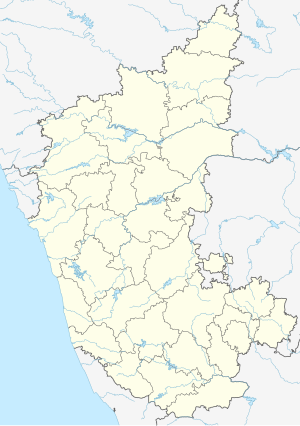
Chandragiri is a suburb and neighbourhood of Tirupati and located in Tirupati district of the Indian state of Andhra Pradesh. It is a part of Tirupati urban agglomeration and a major growing residential area in Tirupati It is the mandal headquarters of Chandragiri mandal in Tirupati revenue division. It also falls in the jurisdictional limit of Tirupati Urban Development Authority. Chandragiri is the southwestern entrance of Tirupati for vehicles coming from Bangalore, Kerala and Tamil Nadu. Kalyana Venkateswara Temple, Srinivasamangapuram is located next to Chandragiri through which well-laid stone footpaths called srivari mettu are available to reach Tirumala on foot

Keladi is a temple town in Sagara Taluk of the state of Karnataka in India. Keladi is located about 8 km from the town of Sagara.

Bangalore is the capital city of the state of Karnataka. Bangalore, as a city, was founded by Kempe Gowda I, who built a mud fort at the site in 1537. But the earliest evidence for the existence of a place called Bangalore dates back to c. 890.
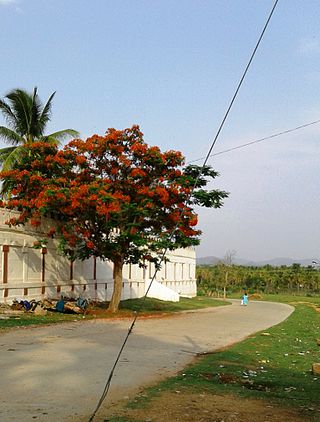
Arsikere is a city and taluka in the Hassan district in the state of Karnataka, India. It is the second largest city in Hassan district, demographically. Arsikere city municipal council consists of 35 wards. This region is known for its coconut production and is also called Kalpataru Nadu. Arsikere Junction is a major railway junction in the South Western Railway which links Mangalore and Mysore to North Karnataka and a central place for tourists who visit nearby places that do not have rail access, such as Belur, Halebidu and Shravanabelagola, Harnahalli, and Kodimata.
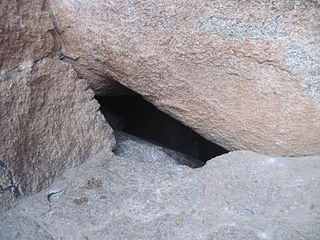
Onake Obavva was a Karnataka warrior who fought the forces of Hyder Ali single-handedly with a pestle (Onake) in the kingdom of Chitradurga of Karnataka, India. Her husband was a guard of a watchtower in the rocky fort of Chitradurga. In the state of Karnataka, she is celebrated along with Abbakka Rani, Keladi Chennamma and Kittur Chennamma, as the foremost women warriors and patriots. She belonged to the Holayas (Chalavadi) community.

Chitradurga is a city and the headquarters of Chitradurga district, which is located on the valley of the Vedavati river in the central part of the Indian state of Karnataka. Chitradurga is a place with historical significance which is located to the North West about 200 km from the state capital Bengaluru. Chitradurga is a major tourist hub in Karnataka.
Bankapura is a panchayat town in Haveri district in the state of Karnataka, India. It is in Shiggaon taluk, is just 2.5 km from the Pune-Bangalore national highway NH-4, 22 km from Haveri town. Bankapura is about 45 km from Hubli-Dharwad. An historical site, Bankapura is famous for the Nagareshwara temple, Bankapura fort, The Bankapura Peacock Sanctuary. Baada, the birthplace of Kanakadasa is near to Bankapura.
Nayakas of Chitradurga ruled parts of eastern Karnataka during the post-Vijayanagara period. During the rule of Hoysala Empire and Vijayanagara Empire, they served as a feudatory chiefdom. Later, after the fall of the Vijayanagara empire, they ruled at times as an independent chiefdom and at other times as a vassal of the Mysore Kingdom, Mughal Empire and Maratha Empire. Finally, their territories merged into the province of Mysore under the British.

Nayakas of Keladi (1499–1763), also known as Nayakas of Bednore and Ikkeri Nayakas, were an Indian dynasty based in Keladi in present-day Shimoga district of Karnataka, India. They were an important ruling dynasty in post-medieval Karnataka. They initially ruled as a vassal of the famous Vijayanagar Empire. After the fall of the empire in 1565, they gained independence and ruled significant parts of Malnad region of the Western Ghats in present-day Karnataka, most areas in the coastal regions of Karnataka, and parts of northern Kerala, Malabar and the central plains along the Tungabhadra river. In 1763 AD, with their defeat to Hyder Ali, they were absorbed into the Kingdom of Mysore. They played an important part in the history of Karnataka, during a time of confusion and fragmentation that generally prevailed in South India after the fall of the Vijayanagar Empire. The Keladi rulers were of the Vokkaliga and Banajiga castes and were Veerashaivas by faith. The Haleri Kingdom that ruled over Coorg between 1600 A.D and 1834 A.D. was founded by a member of the Keladi family.
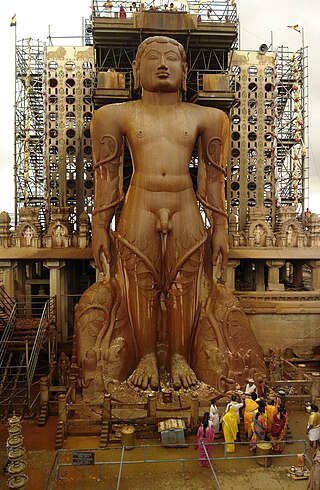
Karnataka, the sixth largest state in India, has been ranked as the third most popular state in the country for tourism in 2014. It is home to 507 of the 3600 centrally protected monuments in India, second only to Uttar Pradesh. The State Directorate of Archaeology and Museums protects an additional 752 monuments and another 25,000 monuments are yet to receive protection.

Chikkaballapura district is a district in the state of Karnataka, India. On 23 August 2007, it was carved out of the pre-existing Kolar district which was the fourth largest district of Karnataka by moving the talukas of Gauribidanur, Gudibanda, Bagepalli, Chikballapur, Manchenahalli, Sidlaghatta and Chintamani into the new district. Kannada is the official language.
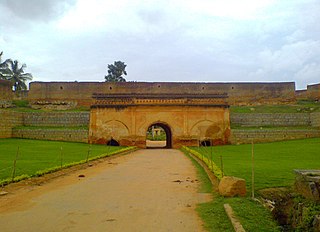
Devanahalli Fort is located 35 kilometers (22 mi) north of Bangalore city, at Devanahalli in the State of Karnataka, India. Chieftain Malla Byre Gowda of Avathi, a Vijayanagara empire vassal, built a mud fort in c. 1501 at Devanadoddi. In the late 18th century, Hyder Ali re-constructed the fort in stone resulting in the current structure.
Uchangidurga is a main Holy & Historical village/town in Harapanahalli Taluk of Vijayanagara District in Karnataka, India. It is 29km away from both Harapanahalli and Davanagere, it is located on state highway 47 & it comes under Harapanahalli taluk of Vijayanagara district in Karnataka.
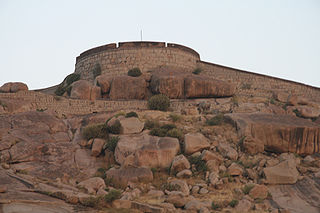
The Bellary Fort was built on top of a hill called the "Ballari Gudda" or the Fort Hill. It is situated in the historic city of Bellary, in the Bellary district, in Karnataka state, India. It was built in two parts namely, the Upper Fort and the Lower Fort. The Upper Fort was built by Hanumappa Nayaka, a feudatory of Vijayanagara Empire, but the Lower Fort was built by Hyder Ali in later part of the 18th century.

The name Karnataka is derived from Karunadu, meaning "lofty land" or "high plateau," due to its location on the Deccan Plateau. The name can also mean "land of black soil" in Kannada. See other possible roots of the name. The recorded history of Karnataka goes back to the Ramayana and Mahabharata epics. The capital of "Baali" and "Sugriva" referenced in the Ramayana is said to be Hampi. Karnataka is mentioned in the Mahabharata as "Karnata Desha." Historically, the region was also called "Kuntala Rajya."

Durgaastamana is a 1982 historical novel by the Kannada novelist and scholar T. R. Subba Rao, popularly known as TaRaSu. As the name indicates, the book charts the downfall of the Nayakas of Chitradurga, a dynasty that ruled there for two centuries. The story follows the epic battle between Madakari Nayaka and Hyder Ali of Mysore in 1779, as the latter lays siege to the fort, and the events and political intrigues leading up to it.

Srirangapatna Fort is a historical fort located in Srirangapatna, the historical capital city of the Kingdom of Mysore in present-day South Indian state of Karnataka. Built by the Timmanna Nayaka in 1454, the fort was modified by later rulers and fully fortified in the late 18th century with the help of French architects. Rulers wanted to protect it against British invaders associated with the East India Company.

Masjid-i-Ala is a mosque located inside the Srirangapatna Fort in Srirangapatna in Mandya District in Karnataka. It was built in 1786-87, during the rule of Tipu Sultan.
Gudekote is a village in Kudligi taluk in Bellary district in the Indian state of Karnataka.


